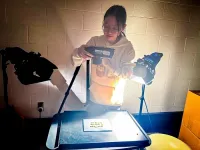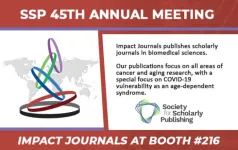(Press-News.org) A new study of more than 50,000 US adolescents across the country indicates that vaping nicotine is strongly linked with an increased likelihood of high levels use of binge drinking and cannabis usage.
The findings, published today in the peer-reviewed journal Substance Use and Misuse, will add to growing public health concerns about the increased popularity of electronic cigarette (or ‘vaping’) use among young people.
“While the overall health risks of vaping are lower than smoking, electronic cigarettes are still harmful to adolescents and warrant ongoing surveillance – especially as the long-term impacts remain unknown,” says lead author, Noah Kreski from the Columbia University Mailman School of Public Health.
“Our results indicate that vaping is not an isolated behaviour, but rather strongly tied to other substance use that can harm adolescents and make quitting nicotine more difficult. Recognising the strong overlap between various forms of substance use, effective intervention efforts should work to simultaneously address vaping, drinking and cannabis use to encourage the health and well-being of young people.”
The researchers used the Monitoring the Future survey – conducted by the National Institute on Drug Abuse (NIDA) – to track trends in the use of cigarettes, alcohol, cannabis, vaping of both nicotine and cannabis, and other substances for children in school grades 8 (13-14 years old), 10 (15-16 years old) and 12 (17–18 years old).
The team examined data from 51,872 adolescents who took part in the survey between 2017 and 2019. They assessed the links between past 30-day nicotine use (non, smoking-only, vaping-only, and any smoking plus vaping) with past 30-day cannabis use – making adjustments to account for certain demographic factors, such as age, sex, race, parental education and urbanicity of the participants.
Looking at nicotine use and cannabis use (in any form, including vaping), they found that, compared to those who did not use nicotine at all, adolescents who:
smoked were 8.03 times more likely to use cannabis.
vaped were 20.31 times more likely to use cannabis.
both smoked and vaped were 40.1 times more likely to use cannabis.
The researchers also found a link between past 30-day nicotine use and two-week binge drinking, even after adjustment. The association between smoking and vaping and binge drinking increased in magnitude at greater levels of binge drinking. For instance, compared to those who did not use nicotine at all, adolescents who both smoked and vaped were:
5.6 times more likely to have participated in binge drinking on one occasion.
21.60 times more likely to participated in binge drinking on three to five occasions.
36.53 times more likely to have participated in binge drinking on ten occasions or more.
“The links between vaping-only, or both smoking and vaping, and cannabis use and binge drinking outcomes in adolescents are particularly striking – especially at the highest levels of binge drinking. While the causal direction of these associations is unclear, the size of the effect is concerning given the harms these substances pose to adolescents,” adds Kreski, who is a Data Analyst at Columbia.
“Given the strong links between nicotine use and both cannabis use and binge drinking, there is a need for sustained interventions, advertising and promotion restrictions, and national public education efforts to reduce vaping in adolescents – efforts that acknowledge co-occurring substance use.”
The authors highlight certain limitations of this study relating to the survey. These include that the data was collected from students during the school day, which excluded those who were absent. Nicotine vaping and smoking were also self-reported by participants, which may be vulnerable to measurement and recall bias.
END
Is vaping a new gateway into further substance use? New national study shows adolescent vapers much likelier to use cannabis and binge drink
2023-05-18
ELSE PRESS RELEASES FROM THIS DATE:
Researchers identify 10 pesticides toxic to neurons involved in Parkinson’s
2023-05-17
Researchers at UCLA Health and Harvard have identified 10 pesticides that significantly damaged neurons implicated in the development of Parkinson’s disease, providing new clues about environmental toxins’ role in the disease.
While environmental factors such as pesticide exposure have long been linked to Parkinson’s, it has been harder to pinpoint which pesticides may raise risk for the neurodegenerative disorder. Just in California, the nation’s largest agricultural producer and exporter, there are nearly 14,000 pesticide products with over 1,000 active ingredients registered for use.
Through a novel pairing ...
Hill Air Force Base and USU sign historic agreement
2023-05-17
A new agreement between Utah State University and Hill Air Force Base will create enhanced learning opportunities for students and spur innovative joint research efforts.
The Education Partnership Agreement was signed on May 11 by USU President Noelle Cockett and Wayne Ayer, a director of the Air Force Sustainment Center’s Engineering and Technical Management Directorate in Ogden.
“There are so many opportunities and technologies that exist within the Air Force that students and faculty can be a part of,” Ayer said. “By ...
SLU Institute for Healing Justice and Equity launches ‘Critical Futures’ podcast
2023-05-17
ST. LOUIS — The Institute for Healing Justice and Equity (IHJE) at Saint Louis University has launched "Critical Futures," a new podcast about imagining alternative futures.
The first episode "Reimagining Community Partnerships" explores anti-racist health policies and structural racism in the health care system and was produced with support from the Robert Wood Johnson Foundation (RWJF), as part of the work of the Anti-Racism Consortium.
“How do we dismantle these systems? What are we building in its wake to move forward so that we can stop having these conversations? Will that happen in our lifetime? ...
Uncovering universal physics in the dynamics of a quantum system
2023-05-17
New experiments using one-dimensional gases of ultra-cold atoms reveal a universality in how quantum systems composed of many particles change over time following a large influx of energy that throws the system out of equilibrium. A team of physicists at Penn State showed that these gases immediately respond, “evolving” with features that are common to all “many-body” quantum systems thrown out of equilibrium in this way. A paper describing the experiments appears May 17, 2023 in the journal Nature.
“Many major ...
NIR spectroscopy provides easy, cost-effective method for food allergen testing
2023-05-17
URBANA, Ill. – Food allergies pose a significant health risk, resulting in numerous hospitalizations every year, as even trace amounts of allergens can trigger severe reactions. Cross-contamination of food products can happen easily in the production process, so it’s important to have reliable methods of testing for allergens.
A new study conducted at the University of Illinois explores the application of near-infrared (NIR) spectroscopy to detect three types of allergens in quinoa flour. The researchers say the method ...
Cash or card? Consumers pay strategically to forget guilty purchases, study shows
2023-05-17
“Will you be paying with cash or card?”
It’s a question that’s been asked of consumers for decades. And despite the increasing popularity of digital payment methods, cash and card remain the most popular choices worldwide. In 2021, 65 percent of all point-of-sale transactions globally were made using cash or card, according to Fidelity National Information Services.
Past research shows that 90 percent of households use multiple payment methods, but new research from the University of Notre Dame takes a first look into how consumers choose between them. The study finds that ...
Impact Journals at SSP 45th Annual Meeting
2023-05-17
BUFFALO, NY-May 17, 2023 – Impact Journals will be participating as an exhibitor at the Society for Scholarly Publishing (SSP) 45th Annual Meeting, which convenes May 31–June 2, 2023, at the Oregon Convention Center & Hyatt Regency Portland in Portland, Oregon, USA. This year, the meeting theme is: “Transformation, Trust, and Transparency.”
“The pace of change in our industry continues unabated, with seismic shifts in areas such as the dissemination of research, business models, and the nature of the workplace. And yet, while pressure for change has become the new normal, ...
Can exercise lower the risk of developing Parkinson’s disease?
2023-05-17
MINNEAPOLIS – Getting regular exercise such as cycling, walking, gardening, cleaning and participating in sports may decrease the risk of developing Parkinson’s disease, according to new research published in the May 17, 2023, online issue of Neurology®, the medical journal of the American Academy of Neurology. The study found female participants who exercised the most had a 25% lower rate of Parkinson’s disease when compared to those who exercised the least. The study does not prove that exercise lowers the risk of developing Parkinson’s disease. ...
Worldwide stroke deaths expected to increase to nearly 5 million by 2030
2023-05-17
MINNEAPOLIS – The number of deaths worldwide from ischemic stroke increased from 2 million in 1990 to more than 3 million in 2019, and is expected to increase to nearly 5 million by 2030, according to a study published in the May 17, 2023, online issue of Neurology®, the medical journal of the American Academy of Neurology. The study focused on ischemic stroke, which is caused by a blockage of blood flow to the brain and is the most common type of stroke.
“This increase in the global death toll of ischemic stroke along with a predicted further increase in the future is concerning, ...
An electric vehicle battery for all seasons
2023-05-17
Many owners of electric vehicles worry about how effective their battery will be in very cold weather. Now a new battery chemistry may have solved that problem.
In current lithium-ion batteries, the main problem lies in the liquid electrolyte. This key battery component transfers charge-carrying particles called ions between the battery’s two electrodes, causing the battery to charge and discharge. But the liquid begins to freeze at sub-zero temperatures. This condition severely limits the effectiveness of charging electric ...




